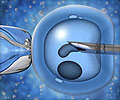Highlights:
- This research studies the correlation between IVF/ICSI and presence of congenital heart defects (CHD) in babies.
- A total of 25856 IVF/ICSI babies and 287995 spontaneously conceived babies were studied
- A total of 337 CHD events were found in the 25856 IVF babies as against 1952 cases in 287995 spontaneously conceived babies
- The researchers concluded that IVF/ICSI babies are more susceptible to congenital heart defects
In current standards of medicine, there is no guideline for IVF/ICSI conceived fetuses to undergo a fetal echocardiogram. The researchers’ objective was to study the incidence and occurrence of congenital heart defects (CHD) in IVF babies as against spontaneously conceived babies. The research used the method of meta-analysis to look for research studies in databases like PubMed/MEDLINE, Embase and Scopus. The researchers used the MeSH (medical subject headings) terms “IVF”, “IVF/ICSI”, “ART pregnancy”, “assisted conception”, “birth defect”, “congenital heart defects” and “congenital malformation or abnormalities” either singly or in permutation combination. They particularly looked for studies detailing CHD in IVF/ICSI conceptions and excluded those conceived through other ART methods. The researchers also excluded other chromosomal abnormalities. The researchers conducted a meta-analysis studies in the selected cohort to come up with an estimated OR (odds ratio). The researchers identified a total of 40 studies for review which included 6 case-control studies (where there was a control group correlated to the group which had the disease of interest) and 34 cohort studies. They used 8 selected cohort studies for an in-depth meta-analysis. The analysis included 25856 IVF/ICSI babies along with 287995 spontaneously conceived babies (single and multiple pregnancies). The researchers found 337/25856 (1.30%) CHD events in IVF/ICSI babies as against 1952/287995 (0.68%) in the spontaneously conceived babies group. The odds ratio for CHD events in the IVF/ICSI group was nearly 1.45-1.55.
What Is In-vitro Fertilization (IVF)?
In-vitro fertilization is one method of Assisted Reproductive Technology (ART). IVF is done by fertilizing extracted eggs and sperm samples and then manually combining these in a lab Petri dish. After fertilization, the embryo is then transferred to the mother’s womb.IVF is used to treat infertility in both males and females. Some of the complications that prevent spontaneous conception include:
- chronic/genetic disorders in males and females
- male fertility factor – decreased sperm count or sperm motility
- damaged or blocked fallopian tubes
- tube removal
- ovarian disorders like fibroids
- idiopathic fertility issues
ICSI involves direct injection of sperm into the cytoplasm of eggs with a fine needle. Once fertilization is successful, the embryo is transferred to the uterus. If the procedure is successful, pregnancy ensues.
There have been some studies indicating congenital anomalies in babies conceived through IVF. Ericson and Källén (2001) conducted a population-based study to ascertain the congenital malformations in infants born after IVF. Similarly, Koivurova et al (2002) conducted a study to understand the neonatal outcome and congenital malformations in children born after IVF. The present study however specifically looks at congenital heart defects in IVF babies.
References:
- Giorgione, Veronica, Fabio Parazzini, Vlasta Fesslova, Sonia Cipriani, Massimo Candiani, Annalisa Inversetti, Cristina Sigismondi, Francesca Tiberio, and Paolo Cavoretto. "Congenital heart defects in IVF/ICSI pregnancy: a systematic review and meta‐analysis." Ultrasound in Obstetrics & Gynecology (2017). DOI: 10.1002/uog.18932
- Ericson, A., and B. Källén. "Congenital malformations in infants born after IVF: a population-based study." Human reproduction 16, no. 3 (2001): 504-509.
- Koivurova, Sari, Anna-Liisa Hartikainen, Mika Gissler, Elina Hemminki, Ulla Sovio, and Marjo-Riitta Järvelin. "Neonatal outcome and congenital malformations in children born after in-vitro fertilization." Human reproduction 17, no. 5 (2002): 1391-1398.
- To know about pregnancy - (http://americanpregnancy.org/)













